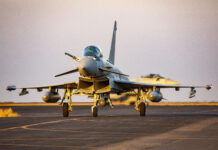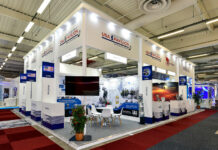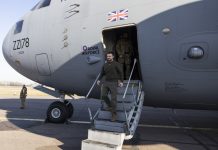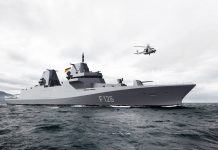The new CEO of Eurofighter struck an upbeat note on the prospects for new sales of the aircraft during a press conference at the Paris Air Show on 21 June 2023.
Giancarlo Mezzanatto, who began his new role on 1 May, told journalists that he sees opportunities to sell an additional 150 to 200 new Eurofighters over the next two years, noting that the company is “much more optimistic than we were some years ago”.
The situation in Ukraine – and Russian President Vladimir Putin’s February 2022 invasion of that sovereign European nation – “has had a huge impact”, said Mezzanatto, who noted that this has led countries to re-examine both what they consider to be adequate armed forces capabilities as well as their previous attitudes to defence exports.
Most crucially, Mezzanatto, suggested that Germany’s refusal to sanction export licences for further Eurofighter sales to Saudi Arabia (a stance taken in light of the October 2018 murder of US-Saudi journalist Jamal Khashoggi and Riyadh’s involvement in the war in Yemen) might soften in light of the Ukraine conflict, adding that “The UK, as lead nation for Saudi Arabia [regarding Eurofighter exports], is really active”.
A future Eurofighter order for Saudi Arabia, which currently operates 72 of the type, could be substantial, involving at least 48 or possibly as many as 72 aircraft.
An order for another 15 Eurofighters could come in the form of electronic warfare (EW) variants for Germany (where they are known as EK variants). Eurofighter is hoping these EK variants will be new-build Tranche 4 aircraft, although it is still possible that Germany might decide to include them within its Project Quadriga order, which covered the acquisition of 38 Eurofighters and was signed in November 2020. In the run-up to the Paris Air Show Saab’s Araxis EW system was declared to be the preferred bid for the Eurofighter EK variants, yet there has been no contract and Saab has been reticent to detail what Araxis solution the Eurofighter would receive; the system can either be fully integrated into the aircraft or come in the form of a missionised pod.
Meanwhile, Eurofighter is anticipating that Spain will soon order 25 new aircraft under its Halcon II project, which is aimed at replacing the EF-18 Hornets operated by the Spanish Air Force out of Torrejon and Zaragoza air bases.
“Spain have an operational requirement to replace their Hornets,” said Mezzanatto, although he noted that a Halcon II contract could be delayed – or even brought forward – by Spain’s national elections in July.
Interestingly, Mezzanatto also said, “I think for Eurofighter Poland is a very good opportunity,” citing the fact that the Polish Air Force has become familiar with the Eurofighter through the type’s deployment to Malbork Air Base in Poland as part of NATO’s enhanced Air Policing (eAP) mission in the Baltic region. The Italian Air Force deployed four Eurofighters to Malbork for four months from August 2022, having completed a seven-month deployment of Eurofighters to Romania on 1 July 2022 (extended from four months due to the Russian invasion of Ukraine).

Mezzanatto’s optimism regarding a Eurofighter sale to Poland is perhaps a little surprising, however, given that Poland has already opted to procure the F-35, of which it ordered 32 in 2020, and in 2022 ordered 48 KAI FA-50 light strike aircraft.
Lastly, Mezzanatto also referenced Turkey, where the UK is leading a sales campaign for the Eurofighter. Turkish was kicked out of the F-35 Joint Strike Fighter programme in 2019 for buying the Russian S-400 air defence system and, although Turkish Aerospace is developing the indigenous Kaan next-generation fighter, the prototype has yet to fly.
Regarding his goals for Eurofighter as a business, Mezzanatto said he wanted to: deliver the Eurofighter’s capability roadmap to keep the aircraft operationally effective out to 2060; be ready to support and ramp up production when additional sales are secured; support the mission readiness of the customer; and continue to promote the strength of the Eurofighter procurement model.
Beyond these goals, however, Mezzanatto is also looking to streamline and harmonise the upgrading of the various national Eurofighter fleets. “One of my objectives is to align as much as possible the configurations of our customers,” he said.
This will be quite a challenge, given the disparities between the user nations in both aspirations and budgets.
Peter Felstead













